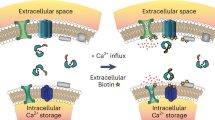Abstract
THE frequency of miniature end-plate potentials (m.e.p.p.s) is increased by passing depolarizing current through motor nerve terminals1,2. Raised extracellular concentrations of potassium ions also cause an increase in m.e.p.p. frequency and this effect has been attributed to depolarization of the nerve terminals2,3. However, while depolarizing current reduces the amount of transmitter released by presynaptic nerve impulses4, raised potassium has the opposite effect3,5. This difference suggests that potassium ions may influence transmitter release by a mechanism distinct from depolarization of the nerve terminals. Such an action could well contribute to the increase of m.e.p.p. frequency caused by potassium. In support of this possibility it has occasionally been observed that the m.e.p.p. frequency in raised potassium continues to increase beyond the time when the ion would be expected to have reached its full concentration at the presynaptic nerve terminals6. The experiments described here were designed to investigate whether there is, in fact, a significant difference between the time taken by potassium to depolarize nerve terminals and the time for full development of the increase in m.e.p.p. frequency.
This is a preview of subscription content, access via your institution
Access options
Subscribe to this journal
Receive 51 print issues and online access
$199.00 per year
only $3.90 per issue
Buy this article
- Purchase on Springer Link
- Instant access to full article PDF
Prices may be subject to local taxes which are calculated during checkout
Similar content being viewed by others
References
Del Castillo, J., and Katz, B., J. Physiol., 124, 586 (1954).
Liley, A. W., J. Physiol., 134, 427 (1956).
Takeuchi, A., and Takeuchi, N., J. Physiol., 155, 46 (1961).
Takeuchi, A., and Takeuchi, N., J. Gen. Physiol., 45, 1181 (1962). Hubbard, J. I., and Willis, W. D., Nature, 193, 1294 (1962).
Edwards, C., and Ikeda, K. L., J. Pharmacol., 138, 322 (1962).
Elmqvist, D., and Quastel, D. M. J., J. Physiol. (in the press). Blackman, J. G., Ginsborg, B. L., and Ray, C., J. Physiol., 167, 389 (1963).
Liley, A. W., J. Physiol., 132, 650 (1956).
Stämpfli, R. L., J. Physiol. (Paris), 48, 710 (1956).
Hubbard, J. I., Schmidt, R. F., and Yokota, T., J. Physiol. (submitted for publication).
Author information
Authors and Affiliations
Rights and permissions
About this article
Cite this article
GAGE, P., QUASTEL, D. Dual Effect of Potassium on Transmitter Release. Nature 206, 625–626 (1965). https://doi.org/10.1038/206625a0
Issue Date:
DOI: https://doi.org/10.1038/206625a0
This article is cited by
-
Glial molecular alterations with mouse brain development and aging: up-regulation of the Kir4.1 and aquaporin-4
AGE (2013)
-
The actions of adenosine and some analogues on evoked and potassium stimulated release at skeletal and autonomic neuromuscular junctions
Naunyn-Schmiedeberg's Archives of Pharmacology (1982)
-
Equivalence of Ca2+ and Sr2+ in transmitter release from K+-depolarised nerve terminals
Nature (1979)
-
Effect of presynaptic neurotoxins from bee and cobra venom on spontaneous mediator secretion from mouse motor nerve ending
Bulletin of Experimental Biology and Medicine (1979)
-
Dual effect of external calcium on the frequency of miniature synaptic potentials in frog sympathetic ganglion cells
Pfl�gers Archiv European Journal of Physiology (1978)
Comments
By submitting a comment you agree to abide by our Terms and Community Guidelines. If you find something abusive or that does not comply with our terms or guidelines please flag it as inappropriate.



